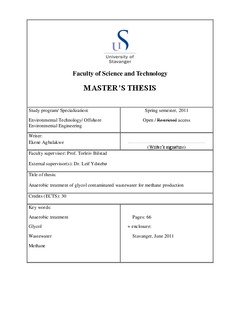| dc.contributor.author | Agbalakwe, Ekene | |
| dc.date.accessioned | 2011-10-04T13:28:10Z | |
| dc.date.available | 2011-10-04T13:28:10Z | |
| dc.date.issued | 2011 | |
| dc.identifier.uri | http://hdl.handle.net/11250/182464 | |
| dc.description | Master's thesis in Environmental technology | en_US |
| dc.description.abstract | Glycols are usually used in the offshore gas industry as hydrate inhibitor in gas pipelines laid deep under the sea. Glycols, in its use, are contaminated by dissolved salts from formation water together with scaling and corrosion products from the pipeline. This results to generation of wastewater containing glycols. Anaerobic treatment may represent an alternative to the aerobic treatment of glycol wastewater. Laboratory-scale studies were carried out to investigate the treatability of glycol wastewater using anaerobic digester reactor. The substrate is a high strength wastewater of about 15000 mg/l COD consisting mostly of monoethylene glycols (MEG) with a pH of 5.4. The microbes used for this study were those from the sewage sludge of IVAR sewage plant and process conditions namely temperature, pH, nutrient requirements, and organic loading rate were optimized to ensure efficient biodegradation. The wastewater treatability and the reactor performance were examined during the study based on the COD removal. Also, the effects of parameters such as pH, SRT, organic loading rate and alkalinity on the COD removal and gas production were monitored. This study was carried out in two experiments. The first experiment was a continuation of an existing working anaerobic reactor while the second was a new system set up. The composition of the nutrients added during the 2nd experiment differs slightly from that of the 1st experiment. From the results in both experiments, there was more gas production in experiment 2 than in experiment. At maximum gas production, COD mass balances of 34.4 % and 83.67 % were obtained in experiment 1 and experiment 2 respectively. The failure of the system may be attributed to the possible presence of toxic substances such as hydrogen sulphide, lack of nutrients and high organic loading rate. | en_US |
| dc.language.iso | eng | en_US |
| dc.publisher | University of Stavanger, Norway | en_US |
| dc.relation.ispartofseries | Masteroppgave/UIS-TN-IMN/2011; | |
| dc.subject | teknisk miljøvern | en_US |
| dc.subject | offshore teknologi | en_US |
| dc.subject | anaerobic treatment | en_US |
| dc.subject | glycol | en_US |
| dc.subject | wastewater | en_US |
| dc.subject | methane | en_US |
| dc.title | Anaerobic treatment of glycol contaminated wastewater for methane production | en_US |
| dc.type | Master thesis | en_US |
| dc.subject.nsi | VDP::Technology: 500::Environmental engineering: 610 | en_US |
| dc.subject.nsi | VDP::Technology: 500::Marine technology: 580::Offshore technology: 581 | en_US |
